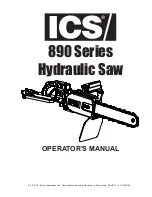
4
GB/IE/NI
• Spring washer, 20 units (d)
• Nuts, 27 units (e)
• Ring spanner, size 10/22 (f)
• Open-ended spanner, size 10 (g)
• Allen key HX 6 (h)
• Hexagonal bolts (k)
5. Intended use
The circular table saw is used for the longitudinal and trans-
verse cutting (only with the transverse stop) of all types of tim-
bers, in accordance with the machine size. It is not permitted
to cut any type of round timber.
The equipment is allowed to be used only for its prescribed
purpose. Any other use is deemed to be a case of misuse.
The user/operator and not the manufacturer will be liable for
any damage or injuries of any kind resulting from such misuse.
The machine is to be operated only with suitable saw blades.
(HM or CV saw blades). The use of any type of HSS saw
blades and cutting discs is prohibited.
An element of the intended use is also the observance of the
safety instructions, as well as the assembly instructions and op-
erating information in the operating manual.
Persons who operate and maintain the machine must be fa-
miliar with the manual and must be informed about potential
dangers. In addition, the applicable accident prevention regu-
lations must be strictly observed.
Other general occupational health and safety-related rules and
regulations must be observed.
m
IMPORTANT
When using the equipment, a few safety precautions must
be observed to avoid injuries and damage. Please read the
complete operating instructions and safety regulations with
due care. Keep this manual in a safe place, so that the infor-
mation is available at all times. If you give the equipment to
any other person, hand over these operating instructions and
safety regulations as well. We cannot accept any liability for
damage or accidents which arise due to a failure to follow
these instructions and the safety instructions.
The manufacturer shall not be liable for any changes made to
the machine nor for any damage resulting from such changes.
Despite use as intended, specific risk factors cannot be entirely
eliminated. Due to the design and layout of the machine, the
following risks remain:
• Contact with the saw blade in the exposed sawing area
• Reaching into the running saw blade (cutting injury)
• Kick-back of workpieces and workpiece parts
• Saw blade breakage
• Ejection of faulty carbide parts of the saw blade
• Hearing damage when the necessary hearing protection is
not used
• Harmful emissions of wood dusts during use in enclosed ar-
eas
Please note that our equipment has not been designed for use
in commercial, trade or industrial applications. Our warranty
will be voided if the equipment is used in commercial, trade or
industrial businesses or for equivalent purposes.
6. Safety information
General power tool safety warnings
m
WARNING: Read all safety warnings, instruc-
tions, illustrations and technical data provided
with this power tool.
Failure to follow the warnings and instructions may result in
electric shock, fire and/or serious injury.
Save all warnings and instructions for future refer-
ence.
The term “power tool” in the warnings refers to your mains-
operated (corded) power tool or battery-operated (cordless)
power tool.
1) Work area safety
a) Keep work area clean and well lit.
Cluttered or
dark areas invite accidents.
b) Do not operate power tools in explosive atmos-
pheres, such as in the presence of flammable
liquids, gases or dust.
Power tools create sparks
which may ignite the dust or fumes.
c) Keep children and bystanders away while op-
erating a power tool.
Distractions can cause you to
lose control.
2) Electrical safety
a) Power tool plugs must match the outlet. Never
modify the plug in any way.
Do not use any adapter plugs with earthed
(grounded) power tools.
Unmodified plugs and
matching outlets will reduce risk of electric shock.
b) Avoid body contact with earthed or grounded
surfaces, such as pipes, radiators, ranges and
refrigerators.
There is an increased risk of electric
shock if your body is earthed or grounded.
c) Do not expose power tools to rain or wet condi-
tions.
Water entering a power tool will increase the risk of elec-
tric shock.
d) Do not abuse the cord. Never use the cord for
carrying, pulling or unplugging the power tool.
Keep cord away from heat, oil, sharp edges or
moving parts.
Damaged or entangled cords increase
the risk of electric shock.
e) When operating a power tool outdoors, use an
extension cord suitable for outdoor use.
Use of
a cord suitable for outdoor use reduces the risk of electric
shock.
f) If operating a power tool in a damp location
is unavoidable, use a residual current device
(RCD) protected supply.
Use of an RCD reduces the
risk of electric shock.











































